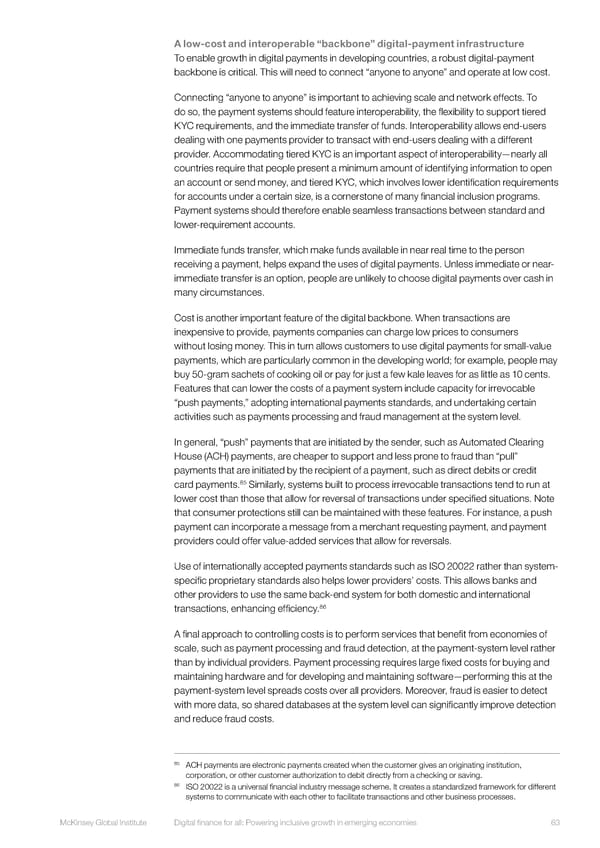A low-cost and interoperable “backbone” digital-payment infrastructure To enable growth in digital payments in developing countries, a robust digital-payment backbone is critical. This will need to connect “anyone to anyone” and operate at low cost. Connecting “anyone to anyone” is important to achieving scale and network effects. To do so, the payment systems should feature interoperability, the flexibility to support tiered KYC requirements, and the immediate transfer of funds. Interoperability allows end-users dealing with one payments provider to transact with end-users dealing with a different provider. Accommodating tiered KYC is an important aspect of interoperability—nearly all countries require that people present a minimum amount of identifying information to open an account or send money, and tiered KYC, which involves lower identification requirements for accounts under a certain size, is a cornerstone of many financial inclusion programs. Payment systems should therefore enable seamless transactions between standard and lower-requirement accounts. Immediate funds transfer, which make funds available in near real time to the person receiving a payment, helps expand the uses of digital payments. Unless immediate or near- immediate transfer is an option, people are unlikely to choose digital payments over cash in many circumstances. Cost is another important feature of the digital backbone. When transactions are inexpensive to provide, payments companies can charge low prices to consumers without losing money. This in turn allows customers to use digital payments for small-value payments, which are particularly common in the developing world; for example, people may buy 50-gram sachets of cooking oil or pay for just a few kale leaves for as little as 10 cents. Features that can lower the costs of a payment system include capacity for irrevocable “push payments,” adopting international payments standards, and undertaking certain activities such as payments processing and fraud management at the system level. In general, “push” payments that are initiated by the sender, such as Automated Clearing House (ACH) payments, are cheaper to support and less prone to fraud than “pull” payments that are initiated by the recipient of a payment, such as direct debits or credit 85 card payments. Similarly, systems built to process irrevocable transactions tend to run at lower cost than those that allow for reversal of transactions under specified situations. Note that consumer protections still can be maintained with these features. For instance, a push payment can incorporate a message from a merchant requesting payment, and payment providers could offer value-added services that allow for reversals. Use of internationally accepted payments standards such as ISO 20022 rather than system- specific proprietary standards also helps lower providers’ costs. This allows banks and other providers to use the same back-end system for both domestic and international 86 transactions, enhancing efficiency. A final approach to controlling costs is to perform services that benefit from economies of scale, such as payment processing and fraud detection, at the payment-system level rather than by individual providers. Payment processing requires large fixed costs for buying and maintaining hardware and for developing and maintaining software—performing this at the payment-system level spreads costs over all providers. Moreover, fraud is easier to detect with more data, so shared databases at the system level can significantly improve detection and reduce fraud costs. 85 ACH payments are electronic payments created when the customer gives an originating institution, corporation, or other customer authorization to debit directly from a checking or saving. 86 ISO 20022 is a universal financial industry message scheme. It creates a standardized framework for different systems to communicate with each other to facilitate transactions and other business processes. McKinsey Global Institute Digital finance for all: Powering inclusive growth in emerging economies 63
 DIGITAL FINANCE FOR ALL Page 77 Page 79
DIGITAL FINANCE FOR ALL Page 77 Page 79